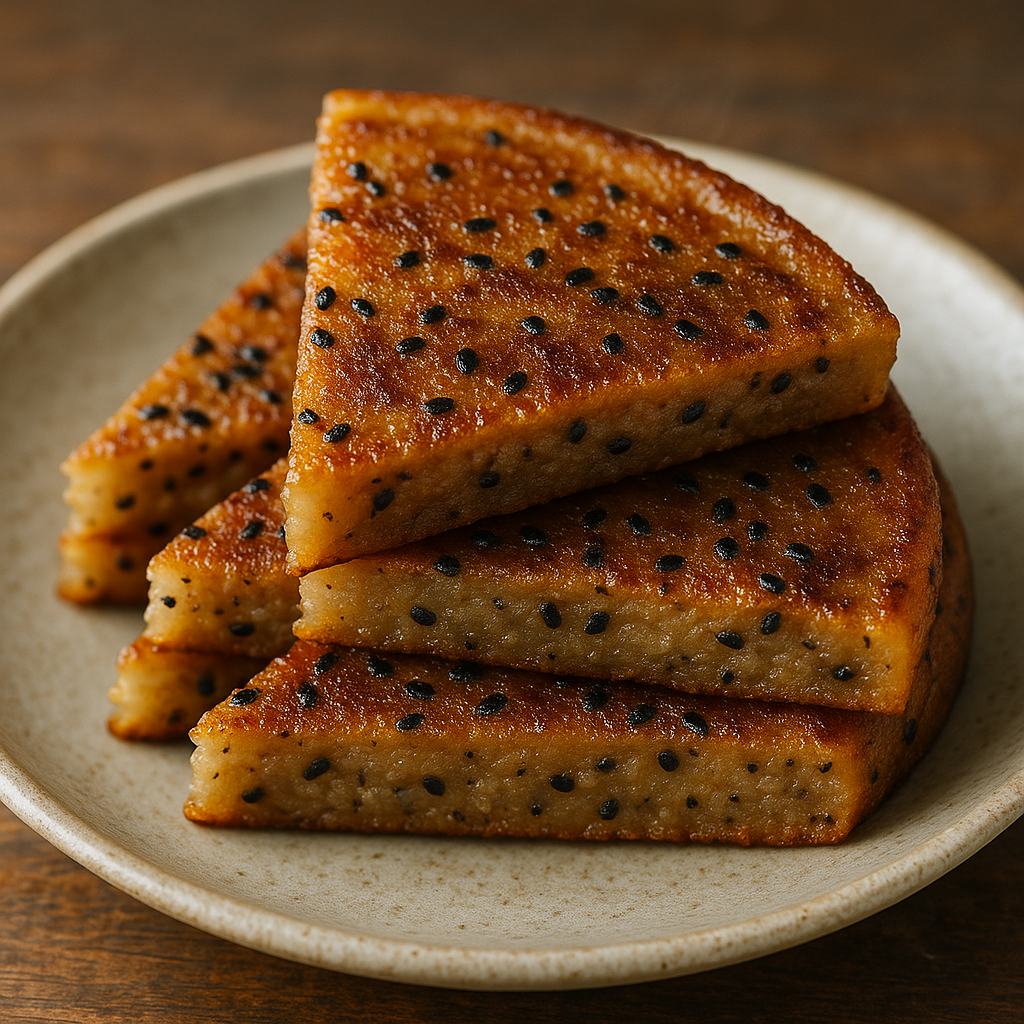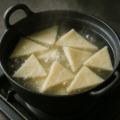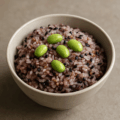がっぱらもちの特徴
津軽の素朴なおやつ、米糊の“糊かす”活用がルーツ
がっぱらもちは、津軽地方に伝わるフライパンで焼く粉菓子。アイロン用の「米糊」を作った際に出る“糊かす”を無駄にしない工夫から生まれたとされます。材料を鍋に「がぱっ」と一気に入れて焼く所作・音が名の由来とも伝わります。
ごはん+小麦粉+黒砂糖+黒ごまを円盤状に焼く
潰したごはんに小麦粉・黒砂糖・黒ごま・塩・水を合わせ、油をひいたフライパンで円盤状に焼いて、ピザのように放射状に切り分けます。外は香ばしく、中はもっちりが魅力。
豆やくるみのアレンジ、地域では“のりかす餅”とも
小豆や金時豆、くるみを混ぜる家庭も。道の駅では一切れ包みで売られることもあり、地域外の人にはちょっと珍しい“おばあちゃんのおやつ”です。
がっぱらもちのレシピ
材料(フライパン1枚分/8〜10人分)
- ごはん … 300g
- 小麦粉 … 50g
- 黒粉砂糖 … 100g
- 水 … 100ml
- 黒ごま … 小さじ2
- 塩 … ひとつまみ
- サラダ油 … 少々
作り方
- すり鉢でごはんを軽くつぶす。
- 小麦粉・黒砂糖・水・黒ごま・塩を加え、混ぜながらさらにごはんをつぶして生地を作る。
- 熱したフライパンに油を薄くなじませ、生地を流して円盤状に整える。
- 弱火でゆっくり両面がきつね色になるまで焼く(縁が少し透けたら返し時)。
- まな板に“がぱっ”とあけ、放射状に8〜10等分に切る。
シェフのワンポイントアドバイス
極弱火でじっくり焼くと、表面は香ばしく中はしっとり。焼き色は火加減で調整し、返す前に縁が乾いてきたかを目安に。
くるみや茹で小豆を少量混ぜても相性抜群です。黒砂糖が無くとも白砂糖でも美味しく出来ます。
栄養価(1切れの目安)
- エネルギー:約120〜150 kcal(8〜10等分時)
- たんぱく質:1〜2.5 g
- 脂質:3〜6 g
- 炭水化物:22〜30 g
炭水化物が中心のエネルギー源。ごま・くるみを加えると香りとミネラル、良質な脂質がプラスされます。
歴史
“もったいない”から生まれた台所の知恵
米どころ・津軽で、米糊づくりの副産物「糊かす」を黒砂糖で甘くして焼いたのが始まりとされ、家庭のおやつとして愛されてきました。名称は、材料を鍋やフライパンに「がぱっ」と入れる所作・音に由来するという説が伝わります。
English Version
Features of Gappara-mochi
A humble Tsugaru snack born from using up rice-paste “leftovers”
Gappara-mochi is a skillet-baked flour treat from the Tsugaru region. It’s said to have started as a way to use the “dregs” left after making rice paste (once used as starch for ironing). Another tale links the name to the lively motion and sound of tipping the batter into the pan in one go—“gapa!”.
Rice + flour + black sugar + black sesame, baked as a round
Mashed cooked rice is mixed with wheat flour, black sugar, black sesame, salt, and water, then spread in a lightly oiled pan as a single round. It’s cut like a pizza: toasty outside, pleasantly chewy inside.
Beans or walnuts as variations—also known locally as “norikasu-mochi”
Some families fold in sweet beans (azuki or kidney beans) or walnuts. You may find single slices sold at roadside stations—a nostalgic “grandma’s snack” that feels new to visitors.
Gappara-mochi Recipe
Ingredients (1 skillet / serves 8–10 as slices)
- Cooked rice … 300 g
- Wheat flour (all-purpose) … 50 g
- Black sugar (kokutō) … 100 g
- Water … 100 ml
- Black sesame seeds … 2 tsp
- Salt … a pinch
- Vegetable oil … a little (for the pan)
Instructions
- Lightly mash the cooked rice in a mortar (or bowl).
- Add flour, black sugar, water, black sesame, and salt; mix while further mashing to make a cohesive batter.
- Warm a skillet and wipe with a thin film of oil. Pour in the batter and shape into a flat round.
- Cook over low heat until golden on the first side, then flip and cook the other side (flip when the edge looks slightly translucent).
- Invert onto a board in one motion and cut into 8–10 wedges.
Chef’s Tips
Use very low heat for a toasty surface and moist interior. Judge the flip by checking that the rim has dried slightly. A handful of chopped walnuts or boiled sweet beans works beautifully. If black sugar isn’t available, white sugar also works.
Nutritional Value (per slice)
- Calories: ~120–150 kcal (when cut into 8–10 pieces)
- Protein: 1–2.5 g
- Fat: 3–6 g
- Carbohydrates: 22–30 g
Primarily a carbohydrate-based energy snack. Adding sesame or walnuts boosts aroma, minerals, and quality fats.
History
Kitchen wisdom born from “waste-not” spirit
In rice-rich Tsugaru, the by-product from rice paste was sweetened with black sugar and pan-baked, becoming a beloved home snack. One naming tale traces “gappara” to the motion and sound of tipping the mixture into the pan in a single “gapa.”



何でも質問してください!